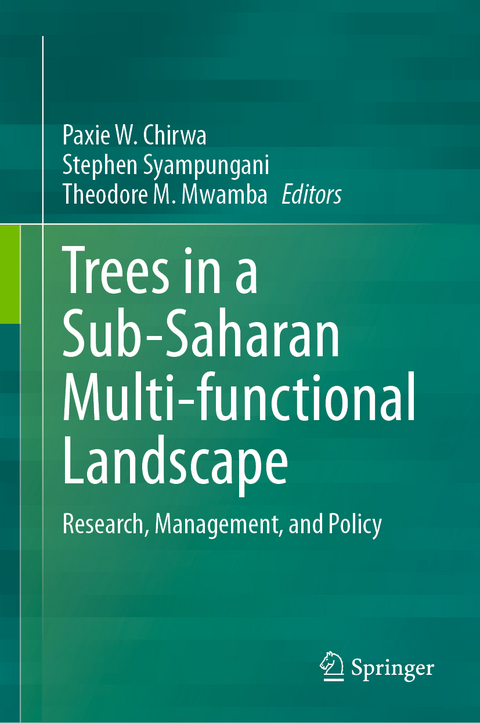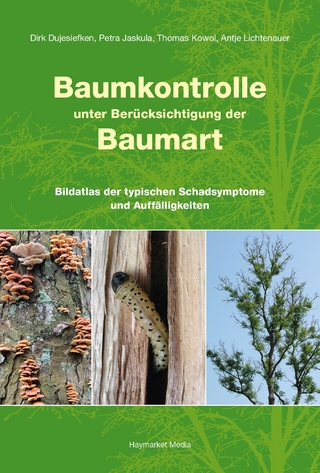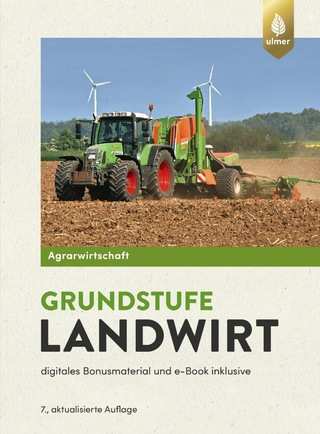
Trees in a Sub-Saharan Multi-functional Landscape
Springer International Publishing (Verlag)
978-3-031-69811-8 (ISBN)
Africa is largely dependent on natural resources in its quest to achieve sustainable development goals, with its woodlands and forests known to be among the most exploited ecosystems. Anthropogenic pressure has led to the progressive conversion of these woodlands and forests into patches of regrowth stands, savanna and cropland systems. Expansion with intensification of agricultural land and the unsustainable use of fuelwood biomass are among the major drivers of such landscape transformations and the associated decline of biodiversity and ecosystem services. This phenomenon is growing in magnitude and significance with emerging environmental issues including climate change, biological invasion, and pollution arising from various land use practices, thereby jeopardizing Africa's development pathway.
Agroforestry holds promises to reverse this trend, as it provides the potential for designing multifunctional agricultural landscapes that guarantee trade-offs of food security, biodiversity conservation, and ecosystem services. Africa is characterized by highly variable ecological conditions and remarkable cultural diversity that influence the conception of landscape multifunctionality. Drawing upon the vast experience of researchers and many other professionals in Africa, this book contextualizes the roles of trees in African multifunctional landscapes, capturing the biophysical and societal diversity in the region, while scrutinizing the ongoing trend of landscape multifunctionality in Africa with reference to the global scenario. It is designed to provide a holistic and comprehensive understanding of the various roles of trees in African landscapes and shed light on the underlying functional attributes of trees, which will help readers to generate a better insight and problem-solving approach for landscape multifunctionality in the context of Africa.
This book defines the multifunctional landscapes with reference to an African context. The book has fourteen chapters, covering five broad thematic areas (i) the multiple services, functions and role of trees in multifunctional landscapes; (ii) tree-based production systems, products and their contributions to rural livelihoods; (iii) drivers of land cover changes and their impacts; (iv) approaches for managing resources to integrate trees in multifunctional landscapes; and (v) external factors affecting landscape resources management in Africa.
Prof Paxie Wanangwa CHIRWA is a Professor of Forest Science in the Department of Plant and Soil Sciences at the University of Pretoria. He is also a Forest Chair for the Forest Science Postgraduate Programme in the Faculty of Natural and Agricultural Sciences.
His area of specialization is socio-ecological systems in forests; agroforestry. He works in forest ecosystems in Africa including the miombo dry forests and woodlands of southern Africa. He has supervised over 21 PhDs and 40 Masters students. He has published over 150 scientific publications in internationally peer-reviewed journals; 21 Book Chapters and Edited 3 Books. He has acted as Guest editor for three special issues of forestry journals; the International Forestry Review, Agroforestry Systems, and the Southern Forest: A Journal of Forest Science. He recently was one of the co-editors of the book "Miombo Woodlands in a Changing Environment: Securing the Resilience and Sustainability of People and Woodlands. Springer, Cham. Ribeiro N.S., Katerere Y., Chirwa P.W., Grundy I.M. (eds) (2020). He was also International Scientific Committee Member for the 2022 Quebec, World Congress on Agroforestry. He is an
Associate Editor: Agroforestry Systems Journal (Springer); Associate Editor: Journal of Forestry Research (Springer); Editorial Advisory Board Member: Southern Forests: A Journal of Forest Science (Francis & Taylor); Editor: Environmental and Geosciences - Scientific African Journal (Elsevier);
Editor: Malawi Journal of Agriculture, Natural Resources & Development Studies; and recently the Carbon Footprint Journal.
Prof Stephen SYAMPUNGANI, is both a Restoration Ecologist and Environmental Engineer focussing on restoration of mine wastelands and environmental risk assessment associated with various developmental activities. He holds a BSc in Forest Science (Copperbelt University), MSc Environmental Engineering (University of Nottingham, UK) and PhD in Forest Ecology (Stellenbosch University, South Africa). Stephen is a Professor of Restoration Ecology at the Copperbelt University as well as an Extra Ordinary Professor in the Department of Plant and Soil Sciences at the University of Pretoria, South Africa. He holds a Professorial Chair of Environment and Development, the Oliver R Tambo African Research Chair Initiative (ORTARChI) Chair funded by the IDRC (Canada), National Research Foundation (NRF) and Department of Science and Innovation (DSI) of South Africa and the National Science and Technology Council of Zambia hosted by the Copperbelt University. Stephen has co-authored a number of publications in the area of Mine wasteland restoration and environment risk modelling.
Chapter 1. Introduction.- Chapter 2. Trees in Multifunctional Landscapes: definition, classification, systems, structure, functionality, examples in Africa.- Chapter 3. Place and roles of trees in a multifunctional landscape: Trees and environmental services.- Chapter 4. Distribution and potential of rocky outcrop plant species in African landscapes.- Chapter 5. Trees and agricultural production systems.- Chapter 6. Promoting crop productivity from Improved Soil Management in Smallholder Farming Systems: Policy implications for smart input subsidy programs in Africa.- Chapter 7. Land use and land cover change in Africa: implications on landscape multifunctionality.- Chapter 8. The Role of Non-Timber Forest Products for Sustainable Livelihoods in African Multifunctional Landscapes.- Chapter 9. Commercialization Potential of Africa's Indigenous Fruit Trees (IFTs) and Their Products for Enhancing Nutrition and Rural Livelihoods.- Chapter 10. Germplasm systems of multipurpose indigenous trees in Africa.- Chapter 11. Management of biological invasions in Multifunctional Landscapes of agroecological ecosystems.- Chapter 12. Socio-ecological management of multifunctional landscapes.- Chapter 13. Socio-economic factors, Policy and Governance systems influencing multifunctional landscapes.- Chapter 14. Securing multifunctional landscapes in Africa: What is the future policy research and development direction?.
| Erscheinungsdatum | 04.10.2024 |
|---|---|
| Zusatzinfo | XXV, 349 p. 40 illus., 38 illus. in color. |
| Verlagsort | Cham |
| Sprache | englisch |
| Maße | 155 x 235 mm |
| Themenwelt | Weitere Fachgebiete ► Land- / Forstwirtschaft / Fischerei |
| Schlagworte | agroforestry • biodiversity • Ecological restoration • Ecosystem services • farm diversification |
| ISBN-10 | 3-031-69811-8 / 3031698118 |
| ISBN-13 | 978-3-031-69811-8 / 9783031698118 |
| Zustand | Neuware |
| Informationen gemäß Produktsicherheitsverordnung (GPSR) | |
| Haben Sie eine Frage zum Produkt? |
aus dem Bereich


